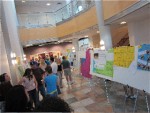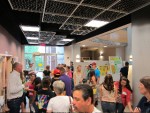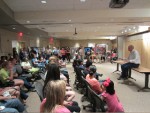As technology advances, collecting large amounts of data becomes easier than ever. One of the challenges facing modern scientists is how to make these data easily accessible and understandable to non-scientist audiences.
The Jornada Basin LTER and Asombro Institute for Science Education posed this challenge to high school students in Las Cruces, New Mexico. In the inaugural Desert Data Jam Competition, students were asked to use Jornada LTER datasets from the EcoTrends website (http://www.ecotrends.info) to create a product that presented the data and conclusions based on the data to non-scientist audiences. In May, students submitted their products and accompanying posters describing their plan for disseminating the products to a large non-scientist population.
The 45 projects were incredibly creative and took advantage of the breadth of datasets available on EcoTrends. Students created children’s books, raps, videos, models, presentations, and infographics. One group created a model made with toy army men to show population growth over time in Doña Ana County, NM. Another group produced a rap and music video about the local employment rate. A third group created an infographic of Merriam’s kangaroo rats of varying sizes holding umbrellas to illustrate that fluctuations in population size were not related to precipitation rates; kangaroo rat sizes were proportional to the population size each year.
On May 7, the student projects were displayed in the USDA/ARS Jornada Experimental Range building on the New Mexico State University campus. During the day, projects were judged by 25 scientist and non-scientist judges, who were impressed by students’ creativity. Projects were judged on their use of data, creativity, dissemination plan, and poster. That evening, the local community viewed projects during an open house (photos 3, 4, 5, & 6)
The top 14 projects were subsequently displayed at the 17th Wildland Shrub Symposium in Las Cruces on May 22. In an awards ceremony at the symposium, the top four student projects were awarded prizes and 10 others received honorable mentions.
First place went to Paula Hoffmann Landau of Mayfield High School who created a children’s activity and story book that focused on the relationship between desert cottontail (Sylvilagus audubonii) and Chihuahuan pocket mouse (Chaetodipus eremicus) population fluctuations in the last decade. The project earned high marks in every judging criterion: It was highly creative, appealing to non-scientist audiences, and was judged to have the potential to reach a large number of people.

 Enlarge this image
Enlarge this image




